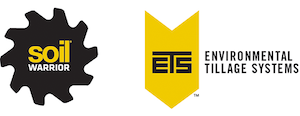On this edition of the Strip-Till Farmer podcast, brought to you by Environmental Tillage Systems, technology editor Noah Newman breaks down everything you can expect at the upcoming 2025 National Strip-Tillage Conference in Iowa City.
Hear from several speakers and past attendees, as they preview their presentations and share some of their biggest strip-till takeaways from past conferences. Noah also answers your biggest questions about the format of the conference and topics on the agenda. Plus, Iowa State’s Rebecca Vittetoe joins the show for a preview of the pre-conference Strip-Till Field Day being hosted by Iowa State Extension.
Head to StripTillConference.com for more information about the National Strip-Tillage Conference, which takes place July 31-Aug. 1 in Iowa City.
|
|
The Strip-Till Farmer podcast is brought to you by Environmental Tillage Systems.
SoilWarrior® systems help you defend your land and improve soil quality. With a choice of durable models, features and accessories, your SoilWarrior helps you minimize erosion while creating precise, nutrient-rich zones.
Let us help you defend your land and improve soil quality. Check out SoilWarrior systems online or request a demo today at www.soilwarrior.com.
Full Transcript
Noah Newman:Hey, welcome to the Strip-Till Farmer Podcast. I'm your host, Noah Newman, technology editor. Big thanks as always to our sponsor, Environmental Tillage Systems, for making this podcast series possible. And hey, today we're going to break down everything you can expect at the upcoming 2025 National Strip-Tillage Conference in Iowa City. We'll hear from several speakers, strip-tillers and past attendees as they preview their presentations and share some of their biggest strip-till takeaways from past conferences. We'll also hear from Iowa State's, Rebecca Vittetoe, and she'll preview the pre-conference Strip-Till Field Day that's being hosted by Iowa State Extension. All right, let's jump in.
Over the next several minutes. We're going to be diving into the National Strip-Tillage Conference Program, and this is supposed to be like a Q&A type session. So I'll be going over kind of the format of the conference, what you could expect, what kind of topics we're going to be covering.And we're also going to hear from some of the speakers throughout as well. We asked them to put together some video previews for us, so we'll be playing those throughout this webinar here.
But let's open up the program here. And again, you could download this as well at striptillconference.com, and that is also the place you can go if you want more information about the conference or you just want to learn more about the speakers. But we'll jump in here and as you can see, this is July 31st and August 1st. We're going to be in Iowa City at the Hyatt Regency Hotel and Conference Center, which is just a top-notch hotel. I love it because it's really easy to get around, easy parking, a lot of great places to eat around the area. Sometimes when you go into a big city downtown, parking is hard to find, there's a lot of traffic, but this is just very convenient location in a beautiful hotel, very nice rooms, wide open hallways.
And as you could see here, now this is a Strip-Till Conference, so strip-till is the big theme, but a lot of different topics get covered here. All the pieces of the strip-till puzzle get covered throughout this two day conference. Fertility strategies, residue management, we're going to talk about biologicals, cover crops, precision technology, soil health and all that, how all those pieces kind of fit into the strip-till puzzle. And as you see here, also if you want to get into town a little bit early, we're going to be kicking things off of a pre-conference field day. It's being hosted by Iowa State Extension in nearby Crawfordsville, which is a short drive from the hotel. And this will be Wednesday, July 30th. And for more information on this field day, I actually caught up with Iowa State's, Rebecca Vittetoe, so we'll play a little preview of that right here.
Do you know how many strip-till toolbars will be out here?
Rebecca Vittetoe:Yeah, so we've got 10 confirmed strip-till toolbars as of right now, so that'll be awesome to have different manufacturers, different strip-till bars here for people to take a look at. We've got about 40 acres that we can work around in to do some of those different demos in. And then in addition to the strip-till bar demos, we've also got some companies that will be joining us just having more of a static display and whether it's the live demos or the static displays, there'll be opportunity for people to visit with those different companies that are here.
Noah Newman:Now, I know our attendees have been asking for an event like this for quite some time. They want to see equipment in action and just what can you say about the value of an event like this for people, maybe some beginner strip-tills or beginner strip-tillers or veteran strip-tillers or even people thinking about getting into strip-till can see this equipment in action?
Rebecca Vittetoe:Yeah, I think anytime you can get out and just see something, get your hands on, it's a great learning opportunity whether you're totally new and you're just thinking about maybe exploring strip-till and just wanting to know what's even out there, or maybe you're a more seasoned veteran and you've been doing strip-till just to kind of see and learn from different people and even share expertise.
Noah Newman:And free to attend, but you're asking people to RSVP so you can kind of get a head count for lunch.
Rebecca Vittetoe:Yep, yep. The Strip-Till Field Day is free to attend. We are just asking that people do register ahead of time. That is more so to help us, like you mentioned, get a head count for lunch. So we're working with our local pork producers, they're going to be grilling some pork burgers for us. Want to make sure-
Noah Newman:Oh, I'm hungry just hearing that.
Rebecca Vittetoe:Want to make sure you have enough pork burgers for everybody.
Noah Newman:Yes, definitely. Looking forward to that and as Rebecca said, the field day is free to attend, but just make sure to go to the Iowa State Strip-Till Field Day website. If you pop that into Google, that'll pop up. And then you could register RSVP for the field day. They're doing a morning session and an afternoon session. They're identical sessions, so depending on your schedule, if you're getting into town a little bit later, you can go to that afternoon session. They'll have lunch like Rebecca said, and also a presenter during lunchtime as well with the Iowa State. So really looking forward to that.
Okay, we have our first question here. Is this conference only for advanced strip-tillers? And my answer that would be no. We have beginners at our conference. We have strip-till veterans, people who've been doing it for a long time, also have a lot of no-tillers and even people that don't practice no-tiller strip-till, but they just want to learn about strip-till and see some of the equipment and different setups.
So yeah, the conference is not only for advanced strip-tillers. If you're a beginner, a veteran, or a non-strip-tiller, there's a little bit of everything for you. So the way it works is we have six general sessions that take place in the main room where everyone gets together. And then we also have 16 classroom sessions. Those are breakout sessions where it's kind of choose your own adventure and those are smaller get togethers and more hyper focused on specific topics. But as we dive into the program here, you'll see the keynote presentation. It starts with Jerry Hatfield, who is a great presenter. I don't know if you've ever seen Jerry Hatfield speak, but he has a lot of great insights and what he does a good job of is taking complex information and really packaging it into a message that people can understand and put to use on their farms.And so he'll be talking about how to build a strong foundation for healthy productive soils with strip-till and create the environment for your crops to reach their full potential. And we're going to hear from Jerry here in a bit with a preview of his presentation.
After Jerry, we'll have Joey Hansen. This is our anniversary lecture because Joey came to the conference, well about 10 years ago and did a presentation about the nuts and bolts of strip-till. And since then he's custom strip-tilled over 100,000 acres in the fall and spring. So he's back with new information. And this will be a really meat and potatoes type strip-till presentation. He'll be covering it all. Different setups, field conditions, strip depth, nutrient management strategies, Joey's going to be covering all of that.
But going back to that last question we got from you guys, and again, if you have any questions you could type them in the Q&A box and I'll see him pop up on my screen here. We've had countless stories of people come into the conference to learn how to strip-till like a Leo Johnson comes to mind. He's a farmer in Wisconsin. He bought a KUHN Krause Gladiator, but he did not know how to use it, didn't know anything about strip-till. So he came to the conference to learn how to strip-till and then he started making his fall strips after going home with all that knowledge that he picked up. So right now-
Leo Johnson:I've always thought that you'll learn more from people's failures than you do from people's successes. And I've always been kind of a student of either businesses that fail or farms that fail or whatever and try to figure out why that is and then try not to do what they did. I mean, I'm not a do-it-yourselfer. I am not mechanically inclined at all. And so I rely heavily on other people to fix stuff and service stuff for me. So I wanted something really easy to run and I found that this KUHN Krause piece was really easy to run. I wanted something that I'd have somebody at the company that I could call in case I had issues or problems.
Patrick Johnson:Sort of like the idea of the accuracy of all of the kind of putting the nutrients where you're actually putting crop. And then the other thing, we kind like the idea of something growing, opening up the soil a little earlier and getting them and then being able to hopefully dry the soil out a little bit quicker in the spring to get in a little quicker. And now this spring we're pretty dry everywhere, so we haven't really seen that benefit, but it had it been a little wetter and it's going to be a difference.
Leo Johnson:I can definitely see the benefits of the fall strip last year and lack of water and wind erosion throughout the winter time. So I wanted to have a good seed-bed to be able to plant into and I didn't want to go the route of chisel plow, field cultivator, whatever. And so this was, to me, it was a good compromise and so far I'm liking what I'm seeing.
Noah Newman:Well that's good to hear, Leo Johnson liking what he's seeing so far. And again, that was Leo from Wisconsin. He came to our Strip-Till Conference a couple of years ago, went home, put the knowledge to work. And Leo talked about learning from successes and failures. That's another thing I love about this conference is that you hear about the success stories a lot, but when you transition to strip-till or you try a new system, it's not always all sunshine and rainbows. So you have people here that are willing to share some of the mistakes they've made or some of the road bumps they encountered and then they could share those with you and then you can watch out for those as you go on to strip-till.
Okay, we have another question here and again, if you're just joining us, thanks again for spinning part of your Friday afternoon with us.I'm Noah Newman, technology editor with Strip-Till Farmer. We're giving you a preview of what to expect at our upcoming National Strip-Tillage Conference, July 31st and August 1st in Iowa City. If you have any questions, type them into the Q&A box. We have one here. Someone wants to know how do classrooms work and are there repeat sessions? All right, so the classrooms you'll see here, choose from four high-powered strip-till classrooms. So these are breakout presentations in some of the smaller rooms at the hotel. And it's kind of a choose-your-own adventure so they don't repeat. So you kind of have to pick which one you want to go to. We have James Hepp here who's going to be doing a strip-till one-on-one type presentation and then Nick Godekin will be talking about nutrient placement. He's an agronomist with a ton of experience, knows a lot about fertility with strip-till.
Daniel H. Smith, university of Wisconsin.He'll be joining us with a presentation about cover crops and using those to help battle herbicide resistant weeds. He'll be sharing some research from some recent trials at the University of Wisconsin. Zach Smith who's really made a name for himself in recent years with some really innovative ideas, he'll be sharing some inner cropping, stock cropping and more just innovative stuff he's doing in his strip-till operation. So we have 16 total classrooms, but this first batch of classrooms, it's choose your own adventure. So we like to recommend if you're with another person or you're in a group, maybe split up and take the divide-and-conquer approach. And we also do record all these classrooms. So since you register for the conference, you'll have access to recordings of every session that we'll send out to you shortly after the conclusion of the conference so you can go back and watch another session if there's one you really wanted to go to but you picked another one instead.
And I will say most of these speakers stick around for the entire day. So if there's a pressing question you have for someone kind of after your classroom's over, it's not a bad idea to maybe book it over to where one of those other speakers is and kind of catch up with him and everyone's really nice and open to sharing some information and very giving with their time as well. So that's what the classrooms are all about. Now, I mentioned earlier Jerry Hatfield will be kicking off our conference exploring strip-till's critical role in the quest for healthier soils. So I caught up with Jerry for a little preview of his presentation and what to expect at the Strip-Till Conference. So let me pull that video up for you. Now, for someone who's never seen one of your presentations before, what can we expect from a Jerry Hatfield presentation?
Jerry Hatfield:Well, that's an interesting question, Noah, in terms of this, but it's really about how do you communicate to producers? I have 45 years of science, but really my dad taught me, he says, "Take all that science and make it understandable to a producer." And that's really what you get out of this, is it's something that everyone that's in the audience should have something to take away and say, "How do I do this?" And if not, ask questions about it. I'm freely available all the time in terms of before and after conferences. People know how to get ahold of me. And it's really about how do we work together in this understanding because there are things that I'll admit that I don't quite understand either yet because we deal in a pretty complex system, I pick up a lot of my crazy ideas of what needs to get done from producers that ask questions. And so it's really about a dialogue and that's what I hope that whole presentation does is create a dialogue.
Noah Newman:Yeah, I've seen your presentation before and you'll share some data and charts and some things that are normally pretty complex. You do a really good job of taking that complex data and information and transforming it into a story that's understandable for farmers.
Jerry Hatfield:And that's what I hope. That's my whole goal is to make it understandable. When I retired from USDA, people asked me what I was going to do and I said, "I'm going to help agriculture." And to help agriculture is you have to really work with agriculture. You can't just stay above it and say, "Well, it's there." You have to get your hands dirty so to speak, but you also have got to pay attention to what is going on and really explain that and not be afraid to say, "I don't know. I don't know how some of these things work, but together we're going to figure them out."
Noah Newman:Now I'm going to put you on the spot with this one, but in all of your research over the years and trials that you've studied, is there anything strip-till related that you learned that was an eye-opener or any big thing about strip-till that surprised you that maybe some people might not know about?
Jerry Hatfield:Yeah, I think the one fascinating thing about strip-till is how uniform that crop is in strip-till. We did some studies where we took that magic 17 and a half feet row to get that thousandth of an acre and we measured every plant in that 17 and a half feet. And in strip-till, those plants are the most uniform of any system that's out there. And that's really where we create a lot of the dynamics of high-yielding system, high-performance systems, high profitability systems, is uniformity among the plants. That surprised us in terms of this and that stays with me to that day is that we love to do strip-till for the fact that we go out and do emergence counts in one day because they all came up at the same time. Everything else, we got a plant here, plant there coming up. So that's the thing that surprised us is uniformity.
Noah Newman:Well, looking forward to learning more of some of your top takeaways during your presentation. And you just touched on it moments ago about having the open dialogue with farmers and coming together and sharing information. So again, in a conference like this, you have beginners, you have some people who have never strip-tilled before who are thinking about getting into strip-till you have the veteran strip-tillers. It's really this big mix. So just how valuable is that in your experience when you go to these conferences and you have all this mix of people sharing ideas?
Jerry Hatfield:I think that's extremely valuable because one of the things that I hope that people do is that, and I'll ask at very front how many people have been doing it for a long time, how many people are here to learn how many people have tried this and have questions? And so that by looking at that, then the audiences maybe they create their own dialogue in themselves, ask questions among each other and everything else. And I've discovered that sometimes in those presentations there's going to be thought-provoking questions that require audience participation. And so you can't sit back and say, "Well, I'm just going to listen." No, you may have to think and say, "I know this, I don't know this," and everything else. So it creates that dialogue as well. So there'll be some pre-talk quiz and there'll be quizzes during the talk that get people just interested in answering maybe some of the questions that are out there.
Noah Newman:Yeah, can't wait for Jerry's presentation. He's another guy that just is so generous with his time. I mean, if you're not able to get your question in during his presentation, he'll hang out by the side of the stage, I'm sure. I don't want to volunteer him for something he is not planning on doing. I don't know what his schedule looks like on that day. But yeah, he usually shares his phone number, exchanges contact info. Jerry's a great guy, so he'll be talking about strip-till's critical role in the quest for healthier soils as we dive back into the program here.
So we'll have our strip-till innovator award presentation as well during the conference. This is with Ray Flickner, first time he's been to the conference and he does a lot of innovative stuff with precision technology, water conservation, and he was an early adopter of strip-till in a Mountain Ridge, Kansas.So looking forward to Ray Flickner's presentation.
So after Ray's general session, then we move on to, well, there'll be a networking lunch. So you will get lunch on Thursday in that main room. And then after lunch and then after Ray's presentation, we'll move on to Jon Stevens who is very entertaining and he always puts all his on-farm experiments under the microscope for all to see. So he'll be talking about how to use strip-till as a tool to improve soil health, enhance your system with livestock and diverse crop rotations and money-saving nutrient management strategies, including the use of an application drone, which I know Jon's trying out on his Rock Creek farm this year for the first time. So we're going to hear from Jon in just a bit, but I want to get back to some of your questions. Someone would like to know, will there be equipment on display?
So yes, our title sponsors big thanks to them, Ag leader, AgSynergy, Dawn, ETS, ForGround by Bayer, Huma, KUHN Krause, Land Luvr, ESN, Ostara, RhizoZorb, Schlagel, Unverferth, Vulcan, Yetter, Zimmerman. So what we do with all our title sponsors is they get a booth in the hallways and we have some big hallways in this Hyatt Regency hotel and conference center. And they get booths and a lot of people will bring maybe a row unit that you can look at and also brochures and some type of equipment or product that you can kind of look over.
So yes, there will be some stuff on display and that's another great thing about this conference is all the networking that happens in the hallways. So yeah, you get a lot of great information in the presentations, but then we build in these networking breaks to kind of give you time to meet with people that maybe you're friends with or meet some new people and exchange ideas. And in the hallways, during those networking sessions, you can really interact with the title sponsors and talk to some manufacturers, pick their brains about equipment setups, strip-till equipment best practices and all that.
All right, let's burn a quick time out and here's a message about environmental Tillage Systems Soil Warriors. Soil Warrior Systems help you defend your land and improve soil quality. With a choice of durable models, features and accessories, your Soil Warrior helps you minimize erosion while creating precise nutrient-rich zones. Let us help you defend your land and improve soil quality. Check out Soil Warrior Systems online or request a demo today at Soilwarrior.com. That's soilwarrior.com. Now back to the conversation.
As I mentioned, Jon Stevens, strip-till maverick proving "it won't work here" wrong. Jon, what could we expect from your presentation? Let's send it out to Jon Stevens.
JonStevens:I'm going to bring in a little bit of some of the fallacies I've discovered through retail ag through my little farming career here. The evolution of the farm and how we got to where we're at, the complete circle of life between the cows and the covers and the rotations and strip-till, no-till, and all that stuff coming together and creating a system for us on the farm and then the retail beef side of things and working with consumers. And then the thing I get most messages about are the nutrient management in a yield limited environment that I'm in. Very poor soils. We ain't got much soil to work with and what we got really isn't that great. And so to be doing an intensive nutrient management program here, a lot of people find very fascinating because I'm hoping that maybe we get to 200 bush of corn when anybody else that's doing this kind of program is setting corn yield records your three, four, 500 yield guys and we're doing it up here for not a yield but for profit.
And so a lot of people find that very fascinating. And so like I said, just the goal, have a good time. And it is fun to go back to this conference. Several years ago I was there, and this is one of the fun parts of why you keep going back is this guy had some questions and he was describing where he was from and this guy over here says, "Wait a minute, do you know so-and-so?" And he, he's like, "Yeah, I know so-and-so," and they start talking. Well it turns out that his uncle is his neighbor and so they almost sort of knew each other and probably crossed paths a bunch of times. "Wasn't that your pickup at the quick trip?" "Yeah, that was me. Oh yeah, yeah." And that's what it's all about is the making new friends and reuniting with your old friends from previous expos.
And so I don't know what more to say, let's just have a great time and I'll do my best to not bore you to death and hold myself together and we'll see what it comes. And so guys, hey, hope to see you there. Thank you very much.
Noah Newman:Well thank you Jon Stevens and we can't wait to see you there. Jon is always a very entertaining speaker. All right, let's jump right back into the program now. We have a lot of speakers this year that have never spoken in our conference before, so there's a lot of fresh perspectives you're going to be seeing at this year's event including Mark Dobson focusing on profitable bushels for sustainable strip-till success. He's going to talk about how to identify and address the Achilles heel in your operation and rethink your entire management plan to increase your breaker profitability without breaking the bank. Wow, we set the bar high with that description, so good luck meeting that one, Mark Dobson. No, Mark's a great guy. Again, Joey Hanson is doing a general session earlier in the day and then he is going to come back and do a breakout classroom on equipment, finding the right toolbar set up for your operation.
And Joey is custom strip-tilled, like we said, over a hundred thousand acres so he's seen it all pretty much in Iowa, Nebraska, South Dakota, multiple states. Stratton Craft, making the trip all the way out from Fort Morgan, Colorado. Again, I think we have speakers from 13 different states this year and attendees from many more states than that, even different countries. We usually have people from Canada. Last year we had someone from Australia, someone from, I want to say Argentina maybe, and yeah, so we have people from all over. Because as we know, strip-tills different for every environment. It's been proven to work in pretty much any state. We've done strip-till success stories from Central California all the way down to Georgia, Florida, Tennessee, of course in the corn belt. So it's just all about making strip-till fit for your unique environment and Stratton Craft will talk about that because he's dealing with some pretty dry conditions out in Fort Morgan, Colorado.
He's actually strip-tilling in circles, so looking forward to hearing about that as we move on to more sessions in the program that's ahead of the curve product learning lab, we'll have a few companies bring their cutting edge technology or product to talk about. We had a request for Red Barn Solutions to appear at the conference and talking about their cover crop seeder that I believe is with the combine. They're doing some pretty unique stuff. So Senterra, Red Barn, Reinvision Ag will talk about their products. Jeff Harrold from Wanatah, Indiana, he has a lot to say about kind of the synergies between soil health and achieving those high yields, so how to achieve those high yields but do it efficiently and have a positive impact on the soil.
Now you'll see these strip-till roundtables, I haven't talked about those yet, so roundtables are not presentations, but they are arguably one of the most popular things about the conference. You pick which roundtable do you want to go to? You see these topics here. We have 14 total and this is the first grouping of seven and it's an unfiltered discussion. It's not a presentation, but there will be a moderator serving as the point guard who gets things going, maybe offers expertise when asked for it or when needed. And then it's just people in the room just sharing their ideas and their challenges and their questions and everyone just helping each other out. So again, seven roundtables in each session and if you're with multiple people, we recommend dividing and conquering, going to multiple ones.
And then end the day wraps up after that. This first Thursday you can go and get dinner on your own, which I had a question pop up, are there any good places to eat near the hotel? My answer to that is, oh yeah, there are a ton of great places to eat. This is why it's one of my favorite locations for the Strip-Till Conference. And you really don't have to get in your car, it's right down the road. Several different options if you're in the mood for pizza, hamburgers, Mexican cuisine, I usually go to 30 Hop when I'm in Iowa City. It's a great restaurant with pretty much any kind of food you could think of on the menu. I think one of the best hamburgers I've had in a long time was at 30 Hop.
So that concludes the first day. Now I want to go back to one of these classroom sessions. We're having Daniel H. Smith share some results from studies about weed management with cover crops and why don't we check in with Daniel now to hear a little bit more about what he's going to be talking about? So Daniel Smith, take it away.
Daniel Smith:Hi, I'm Daniel Smith, outreach program manager for the University of Wisconsin-Madison division of Extensions Nutrient Pest Management Program. Today I'm at the Lancaster Agriculture research Station chatting to you about research that I'm going to be presenting at the 2025 National Strip-Till Conference in Iowa City, Iowa. Very excited about this project because we're comparing conventional till to no-till to various termination timings of cereal rye. We're very interested in using the cereal rye cover crop for weed suppression and at the Lancaster Farm we're lucky enough to have a decent population of waterhemp. During the talk you're going to learn all about the various yields of this study, comparing again no-till, conventional till and those termination treatments of cereal rye, which include two weeks before planting at planting, two weeks after planting, and finally a rye-ledge harvest for our livestock farmers.
We're also going to dive into weed control aspects. So in this study we're also combining pre-emergent herbicides compared to no pre-emergent herbicides, so we've got a lot of weed data to dive into as well. Finally, we're going to talk about how to incorporate some of these systems into your strip-till system. So how can we use winter rye in a strip-till system for weed control and then thinking about pre-emergent herbicides, that might be options as well within that system. Very excited to share this work with you. Look forward to meeting everyone at the conference.
Noah Newman:Thank you very much, Daniel. And we send out surveys every year at the conference asking what you liked, what you didn't like, what you want to see in the program. And a lot of people said, "Hey, we want more research. We want a good mix of farmers, researchers, educators, agronomists." And so we tried to listen to that this year and we have Daniel H. Smith with some research that he's bringing to the table. Dr. Brian Arnall just has a wealth of information about biologicals. He's going to be doing a classroom on that if you're interested in learning more about biologicals, maybe implementing those in your strip-till system.Brian has tested multiple products across 16 locations, so he'll be making the trip up from Oklahoma State.
And then in our final general session, Jared Fender, he is conducting a strip-till trial that there's really nothing like it right now that I could think of. A massive strip-till trial that they launched in 2023 at the University of Illinois under Dr. Fred Bielow, who many of you may know, big name who has presented multiple times at our conference. So Jared's putting together some of the top takeaways and lessons learned from the first year of that trial. So he's going to be bringing that to the conference and that'll be a nice capstone presentation to wrap up the two-day event to go home with some new information that maybe you could put to in your operations. Again, this is July 31st and August 1st in Iowa City Striptillconference.com to register. And you see there on your screen, hey, recommended by 96.3%. Wow, that's a really specific number there. And actually right now, let's hear from someone among that 96.3%. Ryan Nell, he's speaking this year and he's a big fan of the conference. Ryan, take it away.
Ryan Nell:You're not going to be able to go anywhere else in the country or a farm or anywhere to get this amount of strip-till knowledge in one building. I think that's the thing I like the most about it is strip-till is so much different throughout the country. People do it with different machines. Spring, fall, timing, fertilizer. What I like the most about it is if you have a question or something, a concern about it, I can almost guarantee someone there is going to have an answer for you or a situation that they saw because of that. And that's what I really like about it. It's the camaraderie, the social events, the roundtables are so nice, and then even the speakers. You get very knowledgeable people that are willing to share their experiences on that. It really is well worth the time, the drive.
Noah Newman:Well, Ryan's going to be driving from Beaver Dam, Wisconsin I believe, and he does a lot of innovative things with soybeans. So for instance, this year, Ryan wanted to plant soybeans in January, so he gave it a shot. I think he did it on the last day of January. And you'll see here bottom of your screen, there's his presentation reaping the benefits of crazy early strip-tilled soybeans. I would say January fits the description of crazy early. Mitchell Hora, he's a big name in the no-till world and the strip-till world. He'll be talking about some of the latest on cashing in on those renewable fuel tax credits. I know there's a lot of movement going on with that and developments and Mitchell will share the latest. So if you have any questions right now, Q&A box bottom of your screen. How long is each session? Someone wants to know. Each session is about one hour. Now usually the presentations go about 40 to 45 minutes and then that kind of builds in 15 minutes or so for a Q&A if you have any questions at the end.
And yeah, the roundtables are an hour, general sessions an hour, classrooms are an hour. So you really get your bang for your buck, your money's worth with those. We have this SARE classroom. This was a late ad that many people may not have seen. We added this a couple of weeks ago. Actually A farmer's Forum, Bob Recker and Jessica Bezerra de Oliveira. Hope I didn't butcher that name. They will be sharing some of their research and Jessica's actually from Kansas State, so we need to get that updated. She's not from Buffalo Center, she's from Kansas State and they'll be sharing some of their data from the SARE research studies that they did. So big thanks to SARE for sponsoring that session. Gary Zimmer, a biological farming approach to enhancing your strips. Gary brings the energy and he's going to need to bring it Friday morning because he'll kick us off on Friday after breakfast, which is included.So if you join us in the main room at 7:00 AM on Friday, we'll have a nice breakfast and then Gary will get going with his presentation.
Pre-conference Field day gets going Wednesday, hosted by Iowa State. They just ask that you RSVP on their website, the Iowa State Strip-Till Field Day website just so they get a headcount and we'll know how many people are there and they could communicate with you as well, if weather dictates that they have to change things or move inside. All right, that'll wrap things up. Thanks so much for joining. Before we leave, I'm going to play this video of some things that past attendees really liked about the conference, give you another taste of what to expect. Hope to see you July 31st and August 1st in Iowa City and here's a taste of what else you could expect at the conference. Hope to see you there. Talk to you soon.
Chris Perkins:It's my second time being here. I met a couple of people last year and they've actually turned in to be a couple pretty good friends. We kept up with them through the year. They're here again this year. We've already had dinner and drinks last night.
Scott Hoober:Something that I've been involved with for quite a while now. Every couple of years I come to the Strip-Till Conference. There's people here that I've built relationships in the past that are involved with strip-till, so it's good for me to kind of get educated again, just update on what's going on and seeing the new manufacturers that are in the marketplace from a dealer standpoint, see who's doing what.
Melissa Shaw:We just keep coming back to the conference. It's our ninth year. We came to the second one because we didn't know the first one was happening. So we've kept coming back because we keep learning and it's like a family reunion with our ETS family and everyone that we've met. So they can't really get rid of us. We just keep coming back.
Tony McClelland:That's great. I love the Strip-Till Conference. I think it's a great source. It's always helpful to realize that we probably understand less than what we know. And the Strip-Till Conference is a great, humbling way to understand that because you hear different ways of doing things that might work in some areas but not others. And there's some contradictory information, which it all makes sense because it's all for certain sets of conditions. And I think as we understand our soils better and understand our weather and some of the pressures better, we're just going to be better at farming and being more productive and strip-till is going to be a part of that.
Jeff Morgan:There's a high aptitude when you walk in these doors, a high agricultural aptitude and you get it from a broad cross-section. There are people that are doing very intriguing things from different geographies, but just because they're doing it in this state doesn't mean that we can't adopt it for our state at some level. And it's always interesting to hear what other people have tried that worked and things that they tried and didn't work. Sometimes the didn't work lessons are as important as the lessons that did work because if they tried it, somebody else thought about it.
Steve Tesarik:This conference and the sister conference, the No-Till Conference in the wintertime are probably the best two conferences in the country for farmers, agronomists, industry personnel. If you want unbiased uniform opinions and technology that works, this isn't really a university-funded deal and you don't really run into the issues you do with the following the money trail or land-grant colleges and stuff like that. And it seems people shy away from this a little bit, but for what you can learn and pick up at a conference like this, you cannot find anywhere else on the planet. These guys do a great job of putting this thing together and you learn so much with classrooms and roundtable discussions and meeting fellow people from fellow farmers from across the country and what works here, what works there, what doesn't work here, what doesn't work there.
Noah Newman:Thanks for tuning into this edition of the Strip-Till Farmer Podcast. And once again, thanks to our sponsor, Environmental Tillage Systems for making this podcast series possible. Hope to see you in Iowa City July 31st. Until next time, for all things strip-till, head to StripTillFarmer.com.












